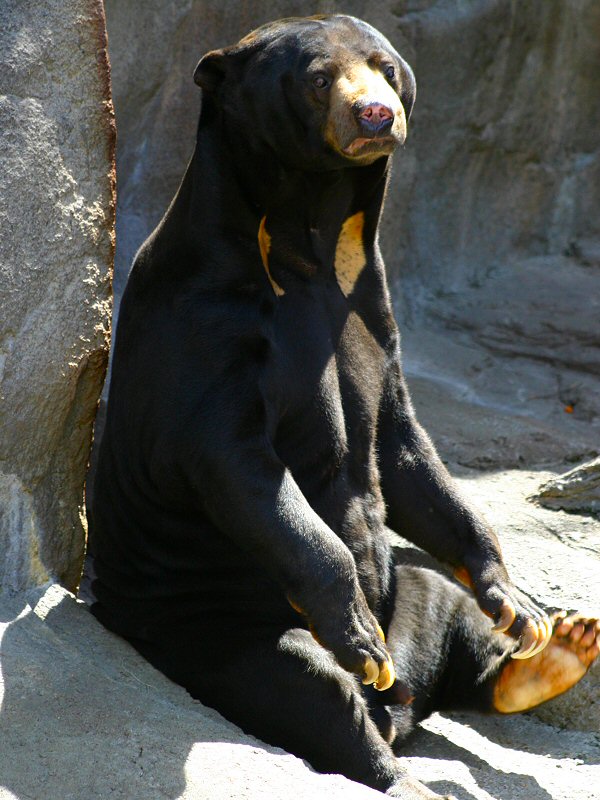| New Photos | Animal News | Animal Sounds | Animal Movies | Upload Photo | Copyright | Korean |
|---|
| Funny Animal Photos | Monsters in Animalia | Wiki Articles Fun Facts about Animals | Links | Home | Mobile A.P.A. |
|---|
| Image Info | Original File Name: Sun Bear (Helarctos malayanus)_sitting.jpg Resolution: 600x800 File Size: 118443 Bytes Date: 2004:04:08 12:31:14 Camera: Canon EOS 10D (Canon) F number: f/5.6 Exposure: 1/180 sec Focal Length: 135/1 Upload Time: 2007:11:13 11:14:07 | |
| Author | Name (E-mail): Unknown | |
| Subject | Sun Bear (Helarctos malayanus) - Wiki | |
 |
| Email : E-Card | Poster | Web Master Delete Edit Info Admin |
| Description | Sun Bear (Helarctos malayanus) - Wiki
Sun Bear
Order: Carnivora Family: Ursidae Synonyms Heliarctus Tilesius, 1850 (unjustified emendation) -------------------------------------------------------------------------------- Ursus malayanus Raffles, 1821 Helarctos euryspilus Horsfield, 1825 Helarctos malayanus Horsfield, 1825 Helarctos anmamiticus Heude, 1901 The Sun Bear (Helarctos malayanus) is a bear found primarily in the tropical rainforests of Southeast Asia. Its Malay and Indonesian name is Beruang Madu ("Honey Bear"). Description The Sun Bear stands approximately 1.2 m (4 ft) in length, making it the smallest member in the bear family. It is often called the "dog bear" because of its small stature. It has a 5 cm (2 in) tail and usually weighs less than 65 kg (145 lb). Males tend to be slightly larger than females; the former normally weigh between 30 and 60 kg (66-132 lb), the latter between 20 and 40 kg (44-88 lb). The Sun Bear possesses sickle-shaped claws that are relatively light in weight. It has large paws with naked soles, probably to assist in climbing. Its inward-turned feet make the bear's walk pigeon-toed, but it is an excellent climber. It has small, round ears and a stout snout. Unlike other bears, the Sun Bear's fur is short and sleek. This adaptation is probably due to the lowland climates it inhabits. Dark black or brown-black fur covers its body, except on the chest where there is a pale orange-yellow marking in the shape of a horseshoe. Similar colored fur can be found around the muzzle and the eyes. This distinct marking gives the sun bear its name. Diet The diet of the Sun Bear varies widely and includes small vertebrates such as lizards, birds, and other mammals, in addition to fruits, eggs, termites, the young tips of palm trees, nests of bees, berries, sprouts, insects, roots, cocoa, and coconuts. Its powerful jaws can crack open nuts. Much of the Sun Bear's food must be detected using its keen sense of smell, as its sight is poor. Lifestyle and reproduction The sun bear does not hibernate, and, as a result, it can reproduce year-round. It is not uncommon for it to give birth to two cubs at a time weighing approximately 10???12 oz (280???340 g) each. The gestation period is about 96 days, but suckling can continue for about 18 months. The offspring reach sexual maturity after 3-4 years and live up to 28 years in captivity. Being a primarily nocturnal creature, the sun bear tends to rest during the day on lower limbs not far above the ground. Because it spends so much time in trees, the sun bear can sometimes cause a good amount of damage to private property. It has been known to destroy coconut palms and cocoa trees on plantations. Threats Adult sun bears have almost no predators except humans. It is known to be eaten on occasion by tigers and by large reticulated pythons, and perhaps the leopard, the clouded leopard, and maybe even by its larger sympatric relative, the asiatic black bear. The recent decline in the sun bear population can be largely attributed to the hunting of "nuisance bears" that destroy crops and poaching driven by the market for their fur and use in Chinese medicine. Sometimes, Sun Bears are captured or bred to be domestic pets--a role for which they are considered desirable due to their relatively inoffensive nature and small size compared to other bears. The IUCN reclassified the the sun bear from data deficient to vulnerable status in 2007. Subspecies Helarctos malayanus malayanus Helarctos malayanus euryspilus, found only on the island of Borneo. http://en.wikipedia.org/wiki/Sun_Bear
| |||
| Copyright Info | AnimmalPicturesArchive.com does not have the copyright for this image. This photograph or artwork is copyright by the photographer or the original artist. If you are to use this photograph, please contact the copyright owner or the poster. |
|
|
|
| |||||||
| CopyLeft © since 1995, Animal Pictures Archive. All rights may be reserved. | ||||||||
Stats